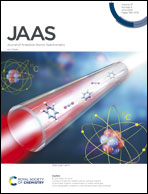Accurate and precise determination of the boron isotope ratio by QQQ-ICP-MS: application to natural waters and carbonates†
Abstract
We present a new method for the accurate and precise (±0.4‰) determination of the boron isotope ratio by single collector QQQ-ICP-MS (Agilent™-8900). The key advantages of our δ11B determination method are pico-gram levels of boron blanks, rapidity of sample preparation and analyses, a low mass requirement of 1.25 ng per analysis, and a relatively high tolerance for ICP-MS matrix mismatch. We utilized a mixture of HF and HNO3 as the ICP-MS matrix for rapid washout of boron and high sensitivity. The long-term instrumental accuracy and precision of δ11B determination are identical to the published results: AE-121 = 19.69 ± 0.26‰ (2σ, n = 40); AE-120 = −20.18 ± 0.23‰ (2σ, n = 16); and AE-122 = 39.60 ± 0.36‰ (2σ, n = 8). This is the first reported boron isotope determination technique based on QQQ-ICP-MS and our accuracy and precision are on par/better than published single collector methods. We also report an improved micro-distillation method, characterized by low procedural blanks (4 ± 3 pg, n = 9) and quantitative boron recovery (98.7 ± 5.5%), for boron purification from carbonate and seawater matrices. The average seawater boron isotopic composition (δ11BSW) of 39.63 ± 0.40‰ (2σ, n = 51) determined on micro-distilled samples is analytically indistinguishable from published values. Additionally, we report identical δ11BSW values of 39.68 ± 0.40‰ (2σ, n = 11) and 39.67 ± 0.42‰ (2σ, n = 18) for the smallest (0.5 μl/2 ng-B) and the largest aliquots (30 μl/120 ng-B) of seawater samples analyzed. However, we report a systematic offset in δ11BSW between aliquots micro-distilled in the HCl matrix (35.43 ± 2.34‰, 2σ, n = 17) and HNO3 matrix (39.63 ± 0.40‰, 2σ, n = 51). The long-term precision of δ11B determination of carbonate samples (δ11BCoral), determined through repeat analyses of our in-house coral standard, is 24.44 ± 0.44‰ (2σ, n = 83). The δ11BCoral of the smallest sample (∼2 mg coral/15–40 ng-B) analyzed (24.36 ± 0.55‰, 2σ, n = 7) is identical to that of the largest mass (∼20 mg coral/100–150 ng-B) sample analyzed (24.49 ± 0.34‰, 2σ, n = 19). Our external precision of ± 0.38‰ (2σ) for foraminiferal δ11B determination, based on seven replicates of Orbulina Universa samples (18.59 ± 0.38‰, 2σ) from ODP Site 664 in the Atlantic Ocean, would enable pH reconstruction at a resolution (ΔpH) of 0.035 units. In summary, this method can be utilized for applications requiring δ11B precision of ≥ 0.4‰ irrespective of boron mass availability.



 Please wait while we load your content...
Please wait while we load your content...